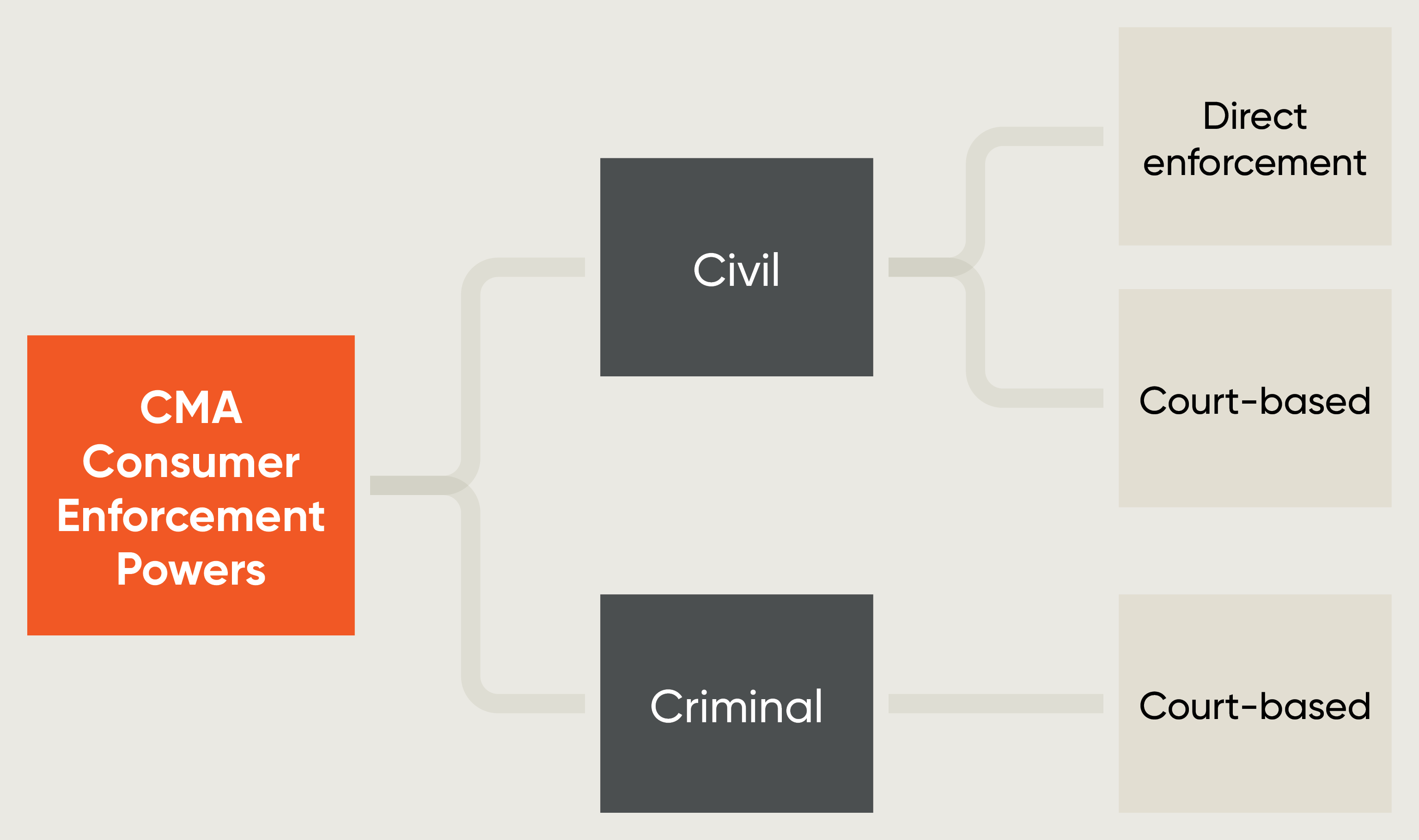Insights
Digital Markets, Competition and Consumer Act – What can we expect from the CMA?
Mar 28, 20252025 is set to be a busy year in UK consumer protection law. With the CMA issuing its annual plan for 2025 / 2026 on 27 March 2025 and its new powers to enforce consumer protection law under the Digital Markets, Competition and Consumer Act (DMCCA) to commence in April 2025, how should you prepare?
In this article, we provide key takeaways from the CMA’s guidance on the overhauled consumer protection regime and look ahead to the key areas where we expect the CMA to shine its enforcement spotlight in the first instance (given the CMA’s draft annual plan and the CMA’s early indications in its 10 March 2025 blog). The CMA has stated that its early enforcement action from 6 April 2025 is likely to focus on what it considers to be the more egregious breaches of consumer law, such as:
- aggressive sales practices that prey on vulnerability;
- provision of information to consumers that is objectively false;
- contract terms that are very obviously imbalanced and unfair;
- behaviour where the CMA has already put down a clear marker through its previous enforcement work; and
- where the law indicates that a practice is always unfair.
In 2025 and 2026, the CMA will also be extending its work to protect consumers from misleading or high-pressure online sales and pricing practices. To inform its consumer protection work, the CMA will be led by insights from the 2024 Consumer Detriment Survey, to be published in Spring 2025. It has previously indicated that likely areas of focus for 2025 will be to act in areas such as drip and dynamic pricing (subject a further CMA consultation on drip pricing guidance in Summer 2025). The CMA has also indicated that the travel, housing and online entertainment sectors will be the subject of regulatory scrutiny and it will continue to look at areas where the CMA has previously set expectations for responsible businesses, such as unregulated legal services and trader recommendation sites.
Key developments
Publication of the CMA draft guidance on unfair commercial practices
Out in early December 2024, the CMA’s guidance on unfair commercial practices (once finalised) will replace OFT guidance OFT1008. The guidance contains a useful series of flow charts and diagrams, setting out the differences between those practices which are only unfair if they are likely to cause consumers to take a different transactional decision (i.e. misleading acts/omissions, aggressive practices, contravention of requirements of professional diligence) and those which are prohibited regardless of the impact on consumer decision-making (i.e. omission of material information from an invitation to purchase, the 32 banned practices and the promotion of unfair commercial practices in a Code of Conduct). It also includes over 100 examples/case studies to illustrate how the new rules may work in practice, as well as useful guidance on when particular categories of consumers may be considered vulnerable (as well as so-called situational vulnerability). In a blog published on 10 March 2025, the CMA stated that it will streamline this guidance considerably to make it as clear and accessible as possible, whilst retaining the case studies and examples which it believes businesses and advisors find helpful. The amended and final guidance is due to be published before 6 April 2025.
The guidance emphasises that the prohibition on contravening the requirements of professional diligence is considered to be a backstop. This may operate to catch practices that don’t infringe the other prohibitions. Professional diligence reflects the standard of honest market practice in a field of activity or the general principle of good faith in a particular field. This is said also to include having regard to a consumer’s legitimate interests/expectations and taking steps to protect these.
Who are your consumers?
The guidance provides that, as a starting point, businesses will need to consider who forms part of their core customer base, as this is likely to affect how they market and offer their products. Businesses must consider the impact of their commercial practices on the elderly, the young, those suffering from mental health conditions, those who may more readily believe certain claims (e.g. due to a particular belief system), circumstances (i.e. situational vulnerability – bereavement, divorce, redundancy).
Presentation of pricing (and other) information
Drip pricing (the situation where the total price of goods or services is only revealed at the end of a transaction with an initial price given at the outset and additional fees added or ‘dripped’ as the transaction progresses) is a key focus for regulators.
Pricing information has to be provided clearly, in a timely manner and in a way a consumer is likely to see. Whilst the format for display of pricing will vary by medium, businesses must ensure presentation utilises space and time as equitably as possible for conveying both headline price and information enabling calculation of total price. If it is genuinely not practicable to do so within the invitation to purchase that contains the headline price, the information enabling the consumer to calculate the total price should be provided in as close proximity as possible and by requiring as few additional actions by the consumer as possible (such as being no more than one click away). The scope of the rules on overall deceptive presentation (a sub-category of misleading actions) is very wide – and again, gives the CMA latitude to consider the impact of online choice architecture and how information is displayed online (e.g. on a webpage or on an app) where there are natural constraints as to what can be displayed on a single page / in a mobile phone window).
The guidance also states that traders should not deliberately structure pricing practices in a way that prevents them from providing a total price which includes reasonably calculable mandatory charges. Where there is a headline price comprising a number of components, a sum should be included for each mandatory element and you can’t include as a component of the headline price the lowest charge a consumer may conceivably pay if in fact this is not in practice attainable (which may affect how delivery charges, mandatory insurance cover and local taxes are presented).
In its March blog, the CMA stated that it will be taking a phased approach to its guidance on drip pricing, noting that drip pricing was the issue it received the most substantive feedback on. In April 2025, the CMA will provide a clear framework for compliance “with aspects of the law which are already well understood and largely unchanged” – the prohibition of genuinely unexpected and untrailed mandatory charges added on at the end of a purchasing journey. For those aspects of the drip pricing guidance that have created more uncertainty (including fixed-term periodic contracts), the CMA will run a further consultation on revised draft guidance in the summer, with a view to producing finalised guidance in this area in the autumn. In the meantime, the CMA has stated that it will only take enforcement action against drip pricing which clearly breaches the rules in line with the April guidance.
Omission of information
The scope of the rules on omissions are also fairly wide, as the CMA also considers information will be considered omitted if provided in a way which is unclear or untimely or the consumer is unlikely to see it. Again, this will impact presentation online/in-app and the guidance specifically calls out the need to be mindful of font size used, positioning and colour of text, use of click through windows and prominence of information provided to consumers (although in the guidance providing context for when it may be possible to omit information, there is not a specific reference to the online environment, only limits posed by packaging size or length of a radio ad). As the price of a product is considered to be material in most circumstances, failing to provide this information in a timely fashion could be a misleading omission. The guidance also specifically references vague green claims as potentially being misleading by omission if the basis on which the claim is made is not also included.
Interestingly, the new rules don’t set out expressly what information will be relevant to a transactional decision, which will give the CMA more discretion to take into account a range of factors (although a non-exhaustive list is included in the guidance).
Businesses must also ensure their practices do not require a consumer to take onerous or disproportionate action in order to exercise rights that a consumer has in relation to a product (which could extend to accessing after sales services, the ability to cancel, product support services, making help desk services hard to access). This may affect those businesses operating call centres which are not responding sufficiently quickly to consumer queries/complaints or are very hard to reach. The examples given in the guidance also include a cumbersome online contract termination process that is awkward to use.
Fake reviews / Annex B guidance
The guidance sets out the CMA’s expectations in relation to fake reviews. A fake review is defined as a consumer review “that purports to be, but is not, based on a person’s genuine experience”
Businesses will need to have a clear policy in place, conduct risk assessments (and review these regularly) and have processes to enable detection and removal of fake reviews. These policies should be readily available to users with clear and prominent signposting and should explain the difference between leaving a review and making a complaint (and traders shouldn’t encourage consumers to submit a complaint rather than leave a review). Businesses will also need an investigations process and to set out the sanctions to be applied when fake reviews are submitted (which could include suspension/revocation of privileges, warnings on trader pages who have made use of banned reviews, banning user accounts associated with fake reviews and/or, terminating memberships of trader recommendation platforms).
The guidance also provides useful context about presentation of reviews (to avoid giving a misleading impression by only publishing positive reviews / burying bad ones) or quoting selectively from reviews to give a misleading impression. Businesses cannot use a moderation process to hold up publication of negative reviews. This means there may be a fine line between performing checks for fake reviews and holding back genuine negative consumer reviews. It will be misleading to suppress negative reviews by editing / withholding them or cherry picking positive reviews or highlighting certain reviews over others.
Businesses should be aware that the concept of a review is very wide, and includes text, speech (opinions in video content) as well as graphic representations (such as star ratings, thumbs up). Any ‘incentivised’ reviews must be clearly identifiable so it is apparent when a user is viewing incentivised content, and these reviews must be distinguished from others (i.e. not included in overall product / trader rankings).
The ability to prevent the publication of fake reviews relies on a business being able to detect these when they are lodged, which may entail additional measures (both manual and automated) to vet reviews. The guidance emphasises that where a publisher cannot put in place effective measures that are reasonable and proportionate in their circumstances to address the need to prevent and remove banned reviews and false or misleading consumer review information (aggregated review information), they should not publish it.
In a blog published on 10 March 2025, the CMA stated that, although it can tackle fake reviews under its existing powers, it recognises that new provisions may require changes to systems and compliance programmes. It has received feedback that businesses need time to bed these in, and so for the first three months of the new regime (from April 2025), it will focus on supporting businesses with their compliance efforts rather than enforcement.
CMA’s Annual Plan 2025-2026
The Plan emphasises the step-change of more direct, impactful consumer protection. It estimates that past enforcement activity by the CMA delivered an annual average of £175.2 million in direct financial benefits to consumers.
The Plan notes that the CMA will have a new Strategic Steer from the UK Government, providing clarity on what it prioritises and how to go about its work. The UK Government's draft Strategic Steer for the CMA was published on 13 February 2025. The draft Steer reflects the benefits that flow from effective competition and consumer protection, placing these within the government’s primary aim of driving economic growth. The draft Steer also provides guidance on the considerations the CMA should have in mind where it has discretion on which issues to tackle, and how best to intervene or design remedies. In relation to consumer protection, the draft Steer states that the CMA should use its new, direct consumer protection powers under the DMCCA to help grow the economy through promoting consumer trust and confidence, while deterring poor corporate practices.
The Plan also sets out that when enforcing consumer protection law, the CMA will continue to consciously prioritise areas of essential spend to help people struggling with pressure on household budgets.
In relation to concurrency (the CMA’s shared powers with sector regulators), the CMA plans develop new approaches to its shared consumer law powers - this will be particularly important in the coming year, where the DMCCA will strengthen sector regulators’ hand in discharging their responsibility to promote consumer protection in their sectors, including by enabling them to apply to court to impose penalties.
Consultation on new consumer protection enforcement guidance
The CMA’s new consumer enforcement powers will come into force from 6 April 2025. As referenced in previous blogs, under the DMCCA, the CMA will, for the first time, have the power to enforce consumer protection laws directly through administrative proceedings (rather than enforcing consumer rights in a court process).
In December 2024, the CMA published its draft consumer protection enforcement guidance, which outlines the CMA’s role and new powers and how it intends to use those new powers alongside other enforcement agencies (the “Enforcement Guidance”). This guidance will replace CMA58 and a final version is due to be published before 6 April 2025. The guidance supplements the CMA’s draft direct consumer enforcement guidance which was published in July 2024 and relates to the CMA’s general approach to carrying out its direct enforcement functions pursuant to Section 212 DMCCA, only (a final version of this guidance is also due to be published before 6 April 2025).
The Enforcement Guidance sets out the various ways in which the CMA may address infringements of consumer law.
The guidance also sets out
- how the CMA decides whether to take enforcement action, the prioritisation principles it applies and which enforcement route to take;
- the use of civil consumer enforcement powers by the CMA and other enforcers;
- the use of criminal consumer enforcement powers by the CMA; and
- the powers available to the CMA and other enforcers to investigate civil and criminal breaches of consumer law including information requests and entering premises.

The CMA states that it will typically focus its consumer enforcement action on particular types of cases, such as where the unfair treatment of consumers, or the challenges they face in making choices, suggests there may be a systemic market problem. Action is therefore more likely to be taken where it would set a precedent or have other market-wide implications or if there is a strong need for deter behaviour or secure compensation for consumers. The CMA has both civil and criminal powers; it is more likely to use its criminal powers when: either court-based or direct civil enforcement is unlikely to be effective in achieving a change in behaviour; and/or the breach is sufficiently serious that the conviction and punishment of offenders ought to be pursued, for example to protect the public and to provide wider deterrence. When pursuing the civil enforcement route, the CMA has stated that it is likely to use its direct enforcement powers.
When considering whether to exercise its powers, recourse will be had to the prioritisation principles, which require the CMA to prioritise according to the strategic significance and impact of its work on consumers. This is balanced against the risks and resources involved, and whether the CMA is best placed to act.
At the same time, the CMA has stated that it will support the vast majority of well-intentioned businesses who want to do the right thing but may be unclear on exactly what is needed to ensure compliance, especially in areas where the law has been updated or there is less clear-cut precedent. It will also take into account where businesses have taken proactive steps to correct infringing conduct, in deciding the appropriate level of a penalty.
Before 6 April 2025, the CMA also plans to publish an “approach document” setting out how it will implement the strategic steer in its approach to consumer work, how it will implement the ‘4Ps’ (pace, predictability, proportionality and process) in this area, and its enforcement priorities for the first 12 months of the new regime with a focus on the most egregious harms.
Transact Globally, Comply Locally - Consumer Protection Issues in eCommerce in the US, UK, & EU
Consumer protection law and its enforcement are changing in many jurisdictions around the world. BCLP panellists from the US, UK and the EU will discuss legal pitfalls to avoid when mapping out the customer journey. Topics covered will include:
- Overview of some Recent Legal Changes and Enforcement Trends
- Price Transparency and 'Drip’ Pricing
- Fake or Compensated Reviews
- Subscription Contracts: Enrollment and Exit Mechanics
Date: Tuesday, 29 April 2025
Time: 9am to 10 am PDT / 12 pm to 1 pm EDT / 5 pm to 6 pm BST
Related Practice Areas
-
Antitrust
-
Commercial Contracts
-
Consumer Products
-
Regulation
-
Retail & Consumer Products







